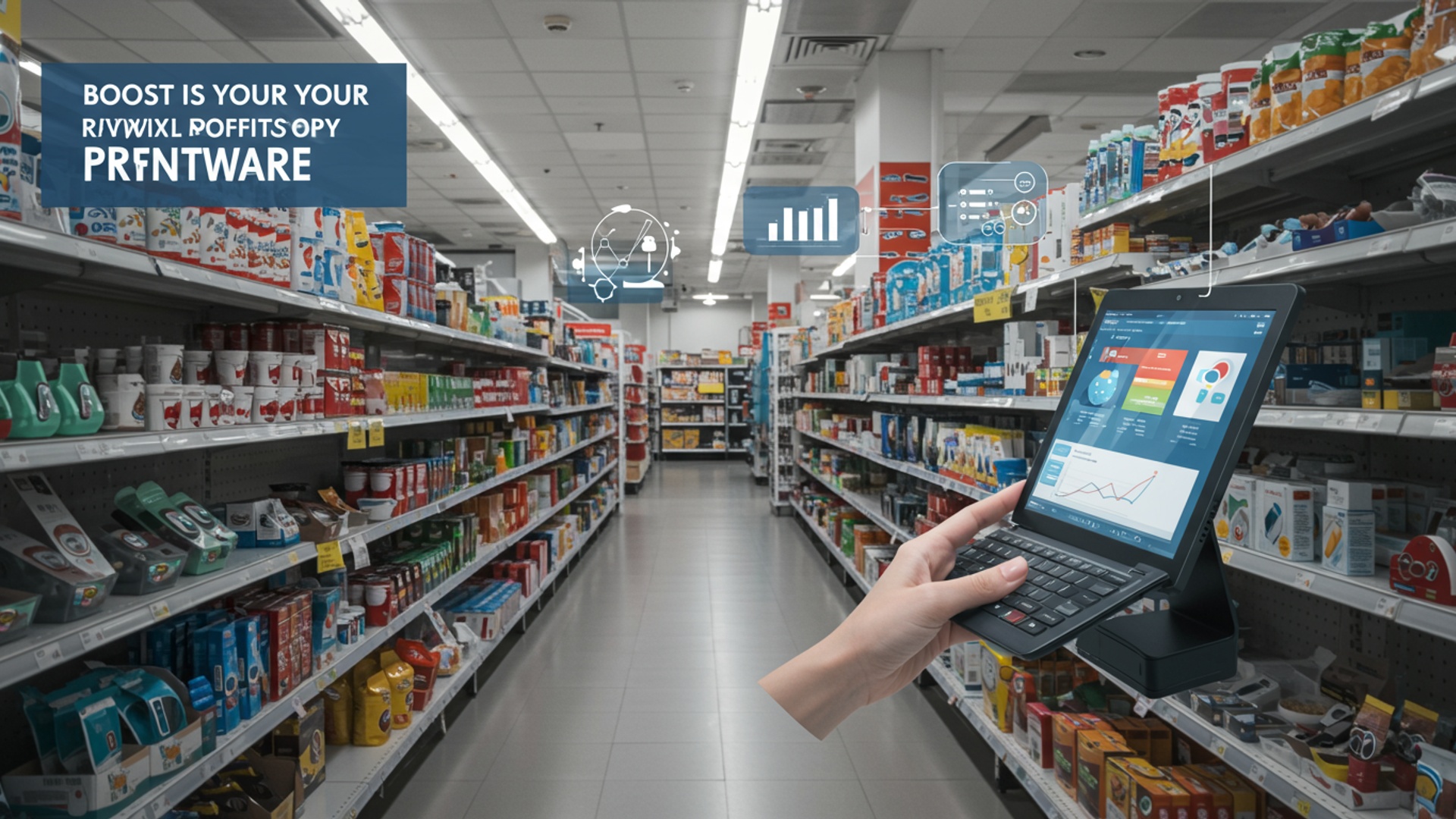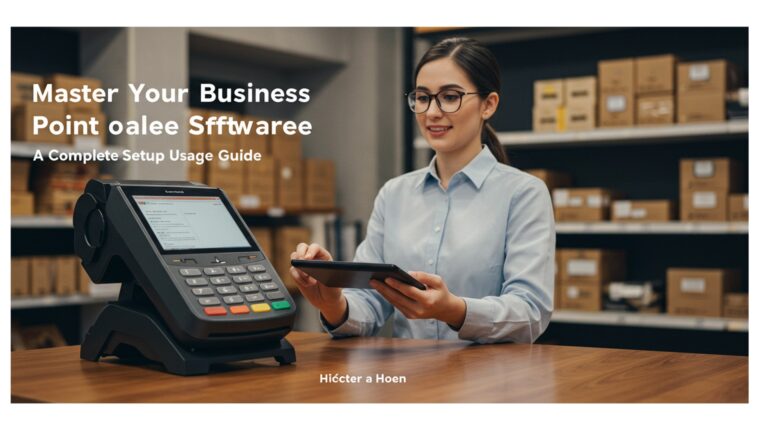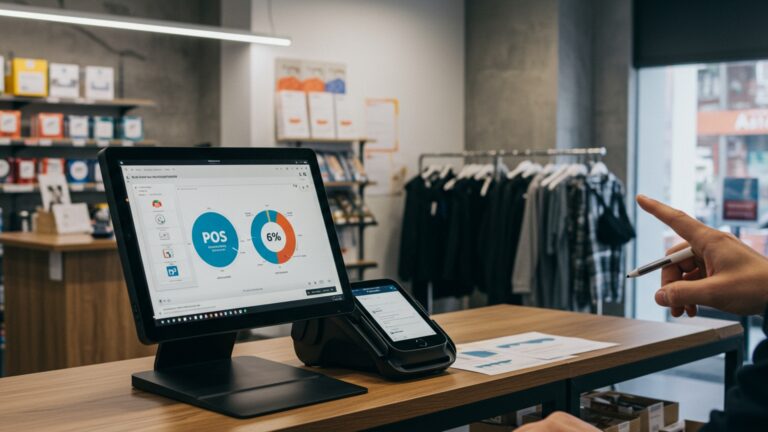Boost Your Retail Profits How to Optimize Inventory Using POS Software
The razor-thin margins in modern retail demand meticulous inventory control, moving far beyond traditional guesswork or quarterly audits. As consumer buying patterns become increasingly fragmented across channels, retailers face the critical challenge of maintaining optimal stock levels without tying up capital in obsolete items or losing sales to empty shelves. Powerful POS software now acts as the central nervous system for retail operations, integrating sales data, returns. even predictive analytics to forecast demand for specific SKUs—consider the surge in home office equipment demand post-2020, or the rapid pivot to sustainable fashion. This real-time intelligence empowers businesses to precisely align inventory with market needs, significantly reducing carrying costs and capitalizing on every sales opportunity.

The Silent Drain: Why Traditional Inventory Management Fails Retailers
For many retailers, inventory management remains a significant bottleneck, silently eroding profits and hindering growth. Without optimized inventory, businesses face a myriad of challenges that directly impact their bottom line and customer satisfaction. Imagine the frustration of a customer seeking a popular item, only to find it out of stock – a lost sale and potentially a lost customer. Conversely, overstocking ties up valuable capital in unsold goods, leading to storage costs, potential markdowns. reduced cash flow.
- Stockouts and Lost Sales: Inaccurate inventory counts lead to missed sales opportunities. Customers often won’t wait for restocks and will simply take their business elsewhere.
- Overstocking and Capital Immobilization: Excess inventory means capital is tied up in goods that aren’t generating revenue. This can lead to increased carrying costs (storage, insurance, obsolescence) and decreased liquidity.
- Manual Errors and Inefficiency: Relying on spreadsheets, pen-and-paper, or disparate systems is prone to human error, consuming valuable time that could be spent on more strategic activities.
- Shrinkage and Loss: Theft, damage. administrative errors (e. g. , miscounts during receiving) contribute to shrinkage, which can be difficult to track and mitigate without robust systems.
- Poor Decision-Making: Without accurate, real-time data, retailers make purchasing decisions based on guesswork rather than insights, leading to a vicious cycle of stockouts and overstocking.
These challenges underscore the critical need for a modern, efficient approach to inventory control. The goal is not just to count products. to strategically manage them to meet demand without excess, ensuring profitability and operational excellence.
Unpacking the Power of POS Software: More Than Just Transactions
At its core, Point of Sale (POS) software is the central nervous system of a retail operation. While historically known for processing sales and payments, modern POS software has evolved into a comprehensive management tool that integrates various facets of a business, with inventory management being one of its most powerful capabilities. Think of it not just as a cash register. as an intelligent hub that connects every sale, return. stock movement to a unified data ecosystem.
A robust pos software system goes far beyond simply ringing up sales. It encompasses:
- Sales Processing: Efficiently handles cash, credit card. mobile payments, along with returns and exchanges.
- Customer Relationship Management (CRM): Tracks customer purchase history, loyalty programs. contact insights.
- Employee Management: Manages staff schedules, sales performance. access permissions.
- Reporting and Analytics: Generates detailed reports on sales trends, product performance. financial data.
- Inventory Management: This is where its transformative power for profit optimization truly shines.
By centralizing these functions, pos software provides retailers with a holistic view of their operations, enabling data-driven decisions that enhance efficiency and profitability. Its ability to seamlessly integrate sales data with inventory levels is the cornerstone of effective stock optimization.
Real-Time Visibility: The Core of POS Software’s Inventory Revolution
The most significant advantage of using pos software for inventory optimization is its capacity for real-time data synchronization. Every transaction, whether a sale or a return, is immediately recorded and reflected in your inventory counts. This eliminates the delays and inaccuracies inherent in manual tracking methods, providing an always-current snapshot of your stock levels.
- Instant Stock Updates: When a product is scanned and purchased, its quantity is automatically deducted from your inventory. Similarly, returns instantly add items back into stock. This immediate update prevents discrepancies and ensures your reported stock levels are always accurate.
- Centralized Data Repository: All inventory details—SKUs, product descriptions, quantities, costs. locations—is stored in a single, accessible database. This eliminates data silos and ensures consistency across all touchpoints, from the sales floor to the back office.
- Reduced Discrepancies: Manual inventory counts are notoriously prone to error. A modern pos software minimizes these errors by automating data entry at the point of sale, significantly improving accuracy.
- Multi-Location Synchronization: For retailers with multiple stores or warehouses, pos software can synchronize inventory across all locations. This means you can see exactly how many units of a particular item are available at each store, enabling efficient stock transfers and fulfilling online orders from the nearest available location.
Consider a scenario: A customer buys a popular pair of sneakers. The moment the transaction is complete, the pos software updates the inventory count, reducing the available stock by one unit. Simultaneously, this update is reflected across all other store locations and your e-commerce platform. This level of immediate, accurate data is indispensable for preventing overselling and ensuring customer satisfaction.
Strategic Inventory Optimization Features Within POS Software
Beyond basic tracking, modern pos software systems come equipped with a suite of sophisticated features designed to move inventory management from a reactive task to a proactive, strategic function. These tools empower retailers to make informed decisions that directly impact their profitability.
- Demand Forecasting & Analytics:
- By analyzing historical sales data, seasonal trends. promotional impacts, pos software can generate accurate sales forecasts. This predictive capability helps retailers anticipate future demand, allowing them to order optimal quantities of products.
- For example, a clothing boutique might notice a consistent spike in scarf sales every October. The pos software can identify this trend, prompting the retailer to increase scarf orders well in advance of the season, preventing stockouts.
- Automated Reordering & Alerts:
- Retailers can set custom reorder points (minimum stock levels) for each product. When an item’s quantity drops below this threshold, the pos software automatically generates alerts or even draft purchase orders to suppliers.
- This feature ensures that popular items are always in stock without human oversight, preventing lost sales due to delayed reordering.
- Multi-Location Inventory Sync:
- For businesses operating across several physical locations or with an integrated online store, pos software centralizes inventory management. Stock levels are updated in real-time across all channels, preventing overselling and enabling efficient inter-store transfers.
- A common scenario: A customer orders an item online. The pos software checks inventory across all stores and warehouses and can fulfill the order from the location with available stock, optimizing shipping costs and delivery times.
- Supplier & Purchase Order Management:
- Streamline the entire procurement process from within the pos software. Retailers can create, send. track purchase orders, manage vendor insights. receive shipments directly into the system, automatically updating inventory counts upon receipt.
- This integration reduces administrative burden and improves the accuracy of incoming stock.
- Loss Prevention & Shrinkage Control:
- Robust reporting features in pos software can highlight discrepancies between recorded inventory and physical counts. This helps identify patterns of theft, damage, or administrative errors.
- Tracking returns and exchanges accurately also helps prevent fraudulent activity and ensures that returned items are either restocked or properly accounted for.
- Product Performance Reporting:
- Gain insights into which products are selling well (fast-movers) and which are languishing on shelves (slow-movers or dead stock). This data empowers retailers to optimize product assortments, identify opportunities for promotions, or liquidate underperforming items.
- For instance, a report might show that a certain brand of coffee sells exceptionally well on weekends, while another brand struggles. This insight allows for targeted marketing or adjustments in ordering.
Beyond the Basics: Advanced Analytics and Integrations
The true power of modern pos software for inventory optimization extends into sophisticated analytics and seamless integration with other business systems. These advanced capabilities transform raw data into actionable intelligence, driving strategic decisions.
- Customizable Reporting & Dashboards:
- Beyond standard sales reports, advanced pos software allows retailers to generate highly customizable reports on various inventory metrics. This includes inventory turnover rates, days sales of inventory (DSI), gross margin return on investment (GMROI). sell-through rates.
- Visual dashboards provide at-a-glance insights into key performance indicators (KPIs), helping retailers quickly identify trends, opportunities. areas of concern. For example, a dashboard might show a sudden dip in sales for a traditionally strong category, prompting investigation.
- Integration Ecosystem:
- The ability of pos software to integrate with other essential business platforms creates a unified operational environment.
- E-commerce Platforms: Seamlessly synchronize inventory between your physical stores and online shop, preventing overselling and ensuring consistent stock levels across all channels.
- Accounting Software: Automatically push sales and inventory cost data to accounting systems like QuickBooks or Xero, streamlining bookkeeping and reducing manual data entry errors.
- Enterprise Resource Planning (ERP) Systems: For larger retailers, integration with ERP systems provides an even broader view of business operations, connecting inventory with supply chain, manufacturing. financial data.
- Mobile Inventory Management:
- Many pos software solutions offer mobile applications or handheld scanners that allow staff to perform inventory tasks on the go.
- This includes conducting physical counts, receiving shipments, transferring stock between locations. checking product data directly from the sales floor or warehouse. This significantly boosts efficiency and accuracy, reducing the need for back-office data entry.
A Retailer’s Success Story: From Chaos to Control with POS Software
Let’s consider “The Artisan’s Nook,” a growing boutique specializing in handmade jewelry and unique gifts. For years, Sarah, the owner, managed her inventory manually using spreadsheets and regular physical counts. While charming, this approach was becoming a significant drain as her business expanded to two locations and an online store.
Before POS Software:
- Sarah frequently experienced stockouts of her most popular artisan necklaces, leading to disappointed customers and lost sales.
- Conversely, she often had excess inventory of less popular items, tying up capital in products that sat on shelves for months, eventually requiring deep discounts.
- Physical counts were a weekly, all-day affair, often revealing discrepancies that were difficult to trace. This meant closing early or staying late, impacting staff morale and productivity.
- Managing orders for her two stores and online platform was a nightmare of cross-referencing spreadsheets, often leading to overselling online only to find an item was out of stock in both physical stores.
Implementing POS Software:
Sarah decided to invest in a comprehensive pos software system with robust inventory management capabilities. The transition required initial setup. the benefits quickly became apparent:
- Real-time Accuracy: Every sale at either physical store or online automatically updated the central inventory. Sarah could see exact stock levels across all channels at any moment.
- Automated Reordering: She set reorder points for her best-selling items. When stock dipped below a certain level, the pos software alerted her, allowing her to place timely orders with her artisans.
- Data-Driven Decisions: Using the pos software‘s reporting features, Sarah identified that specific types of handmade candles sold exceptionally well during winter holidays, while certain jewelry pieces were consistent sellers year-round. This insight allowed her to optimize her purchasing strategy, avoiding overstocking slow-movers and ensuring she had ample supply of popular seasonal items.
- Reduced Shrinkage: The system’s detailed tracking helped her identify discrepancies more quickly, indicating potential issues with receiving or internal processes, leading to tighter controls.
- Improved Cash Flow: By optimizing inventory levels, Sarah significantly reduced the capital tied up in excess stock. This freed up funds for marketing, store improvements. even expanding her range of unique products.
Sarah’s story is a common one. By leveraging the power of pos software, “The Artisan’s Nook” transformed its inventory from a source of stress and lost revenue into a finely tuned component of a profitable and growing business.
Choosing Your Inventory Optimization Partner: What to Look for in POS Software
Selecting the right pos software is a critical decision that can profoundly impact your retail business’s efficiency and profitability. It’s not just about finding a system that processes transactions; it’s about identifying a partner that empowers you to optimize your inventory and streamline your entire operation. Here are key considerations and a comparison of typical features:
- Scalability: Can the pos software grow with your business? If you plan to open more locations or expand your product lines, ensure the system can handle increased volume and complexity without requiring a complete overhaul.
- Ease of Use: A powerful system is only effective if your staff can use it efficiently. Look for intuitive interfaces, minimal training requirements. responsive design.
- Integration Capabilities: How well does the pos software integrate with your existing or future systems (e. g. , e-commerce platforms, accounting software, CRM)? Seamless integration prevents data silos and enhances overall efficiency.
- Reporting and Analytics Depth: Go beyond basic sales reports. Look for robust inventory reports, demand forecasting tools. customizable dashboards that provide actionable insights.
- Vendor Support: Reliable customer support is crucial. Assess the vendor’s reputation for technical assistance, training. ongoing updates.
- Cost Structure: comprehend the total cost of ownership, including subscription fees, hardware costs, setup fees. potential transaction fees.
- Specific Inventory Features: Does it offer automated reordering, multi-location management, lot tracking, or serial number tracking if your business requires it?
To help you compare, here’s a table outlining common inventory-related features across different tiers of pos software:
| Feature | Basic POS Software | Advanced POS Software | Enterprise POS Software |
|---|---|---|---|
| Real-time Stock Tracking | Yes (Single Location) | Yes (Multi-Location) | Yes (Multi-Location & Warehouse) |
| Manual Reorder Point Alerts | Yes | Yes, Automated Suggestions | Fully Automated Reordering with Vendor Integration |
| Basic Sales Reports | Yes | Yes, with Product Performance & Trend Analysis | Advanced Predictive Analytics, Customizable Dashboards |
| Supplier & PO Management | Basic PO Creation | Integrated POs, Vendor Database | Full Supply Chain Integration, Automated Vendor Communication |
| E-commerce Integration | Limited / Manual Sync | Seamless Two-Way Sync | Unified Commerce Platform |
| Mobile Inventory Management | No / Basic App | Yes, for Stock Counts & Receiving | Comprehensive Mobile Suite for All Inventory Tasks |
| Loss Prevention Tools | Basic Discrepancy Reports | Advanced Shrinkage Analysis, Return Tracking | AI-Powered Anomaly Detection |
| Kitting/Bundling | No | Yes | Yes, with Complex Assembly Management |
Actionable Steps for Implementation
Once you’ve chosen the right pos software, successful implementation is key to unlocking its inventory optimization potential. Follow these actionable steps to ensure a smooth transition and maximize your return on investment:
- Conduct a Thorough Physical Inventory Count: Before migrating to a new system, perform a comprehensive, accurate physical count of all your existing stock. This establishes a clean baseline for your new pos software system.
- Standardize Product Data: Clean up your product catalog. Ensure every item has a unique SKU, consistent naming conventions, accurate descriptions. correct pricing. This prevents errors and improves reporting.
- Define Reorder Points and Safety Stock Levels: Based on historical sales data and lead times, set appropriate reorder points and safety stock levels for your key products within the pos software. Start with your fastest-moving items.
- Integrate Suppliers and Vendors: Set up your vendor data and integrate any electronic data interchange (EDI) capabilities if your pos software and suppliers support them. This streamlines future ordering.
- Train Your Staff Thoroughly: Invest time in training your employees on how to use the new pos software, especially for inventory-related tasks like receiving new stock, processing returns. conducting cycle counts. Understanding the system ensures data accuracy.
- Leverage Reporting and Analytics: Don’t just set it and forget it. Regularly review the inventory reports generated by your pos software. Look for trends, identify slow-moving items. adjust your purchasing strategies accordingly.
- Schedule Regular Cycle Counts: While pos software enhances accuracy, periodic cycle counts (counting a small section of inventory regularly) help verify the system’s data and catch any discrepancies early.
- Set Up Alerts and Notifications: Configure your pos software to send automated alerts for low stock levels, pending orders, or unusual inventory movements. This allows for proactive management.
By following these steps, retailers can effectively harness the power of pos software to transform their inventory management, reduce costs, boost sales. ultimately achieve higher profitability.
Conclusion
Ultimately, harnessing your POS software isn’t just about recording sales; it’s about transforming raw data into a powerful engine for inventory optimization and profit growth. Your journey to mastering inventory begins with consistent data entry and, crucially, diligent analysis. My personal tip? Don’t just set reorder points and forget them; regularly review your slow-moving items and sales velocity reports, perhaps weekly, as market dynamics shift rapidly. For instance, after noticing a recent spike in demand for sustainable packaging, a quick check of POS data confirmed the trend, allowing for timely stock adjustments that prevented lost sales. Embrace the power of predictive analytics, a growing trend in modern POS systems, which can forecast demand with surprising accuracy, letting you anticipate rather than react. Remember, every piece of data your POS collects is a clue to unlocking greater efficiency. Take charge of your inventory, transform your retail operations. watch your profits flourish.
More Articles
A Practical Guide to Mastering Business Operations with POS Software
The Essential Guide to Choosing POS Software for Retail Success
The Ultimate Guide to Understanding Essential POS Software Features
Learn How Smart POS Billing Software Boosts Business Efficiency
Uncover the Best POS Software in India for Small Businesses
FAQs
Why should I bother using POS software to optimize my retail inventory?
Using POS software for inventory isn’t just about counting items; it’s about making smarter decisions. It gives you real-time data on what’s selling, what’s not. what you have on hand. This helps you avoid running out of popular items (missing sales) and also prevents you from stocking too much of what nobody wants (tying up cash).
How does a POS system actually help me manage my stock better?
A good POS system automatically tracks every sale, return. transfer, constantly updating your inventory counts. It can show you sales trends, identify your best and worst sellers. even suggest reorder points. This means less manual counting, fewer errors. a much clearer picture of your stock levels at any given moment.
What specific inventory problems can this approach solve for my business?
It tackles common headaches like dead stock (items that just sit there), stockouts (when you run out of something popular), inaccurate counts. inefficient ordering. By using POS data, you can reduce waste, improve product availability. ensure your shelves are stocked with what your customers actually want.
Will optimizing my inventory with POS really make a noticeable difference to my profits?
Absolutely! By reducing overstock, you free up capital that was tied up in unsold goods, improving your cash flow. Minimizing stockouts means you don’t miss out on sales opportunities. Plus, efficient inventory management often leads to lower storage costs and less product spoilage or obsolescence, all of which directly boost your bottom line.
Is it complicated to get started with inventory optimization using POS?
It doesn’t have to be. Most modern POS systems are designed to be user-friendly. The initial setup involves inputting your current inventory data. once that’s done, the system handles a lot of the heavy lifting automatically. Many providers also offer training and support to help you get the most out of the features.
What kind of useful reports or insights can I get from my POS for inventory management?
You can pull a variety of reports, such as detailed sales analytics by product, category, or even vendor. It can show you inventory turnover rates, identify slow-moving items versus bestsellers. provide accurate inventory valuation. Some systems even offer predictive analytics to help forecast future demand.
Can POS software help me automate the reordering process for new products?
Yes, many advanced POS systems include features for automated reordering. You can set minimum stock levels for each product. when inventory dips below that point, the system can automatically generate a purchase order or alert you to reorder. This ensures you maintain optimal stock levels without constant manual checks.






